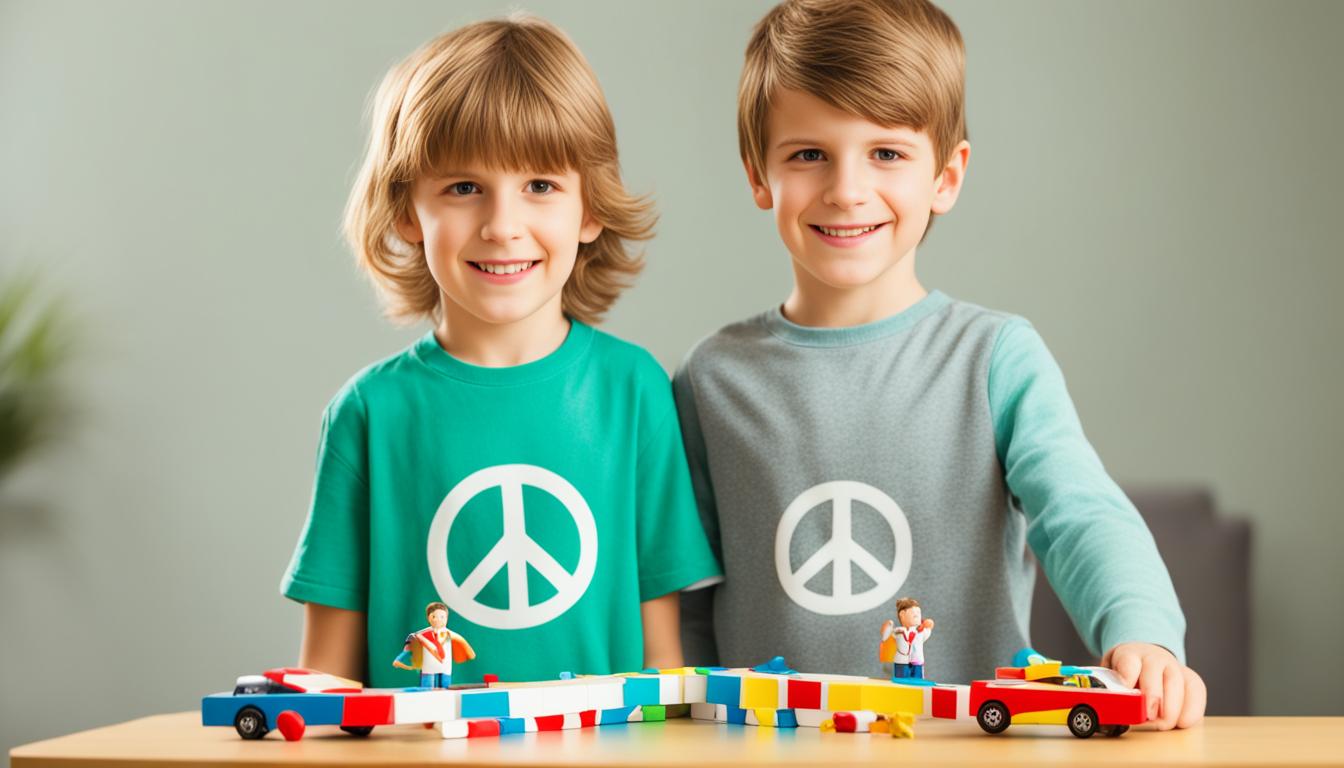
Solving Sibling Rivalry: Effective Solutions for Peace at Home
Sibling rivalry is a common challenge that many families face. It can lead to tension, conflict, and a breakdown in family harmony. However, there are effective solutions that parents can implement to promote peace and reduce sibling rivalry in the home. By setting clear expectations, encouraging communication and problem-solving, teaching conflict resolution skills, and fostering a positive and supportive family environment, parents can create a home where siblings can coexist peacefully and enjoy a strong and loving relationship.
Key Takeaways:
- Setting clear expectations helps prevent conflicts and provides a framework for peaceful coexistence.
- Encouraging communication and problem-solving skills strengthens sibling relationships and resolves conflicts effectively.
- Fostering a positive and supportive family environment promotes brotherly and sisterly bonds.
- Consistency, patience, and support from parents are crucial in implementing these solutions.
- By empowering children with the skills and tools to navigate conflicts, families can enjoy a harmonious home where sibling rivalry is minimized and peace prevails.
Setting Clear Expectations
One of the key solutions to reducing sibling rivalry is setting clear expectations. This involves establishing clear rules, boundaries, and consequences for behavior. By clearly defining what is expected of each child, parents can help prevent conflicts and provide a framework for peaceful coexistence.
This can include guidelines for:
- Sharing toys and personal space
- Taking turns
- Respecting each other’s belongings
- Using respectful language
When expectations are clear, children have a better understanding of what is acceptable behavior, leading to a reduction in sibling rivalry and conflicts.

Encouraging Communication and Problem-Solving
Effective communication and problem-solving skills are essential in preventing and resolving sibling rivalry. Encouraging open and honest communication between siblings is key to fostering understanding and empathy. By providing opportunities for children to express their feelings, thoughts, and concerns, parents create a safe and supportive environment where sibling relationships can thrive.
I believe in the power of regular family meetings to promote communication and problem-solving. These meetings provide a platform for each family member to share their perspective and contribute to finding solutions. It allows siblings to understand each other’s point of view and learn essential problem-solving skills.
One method to facilitate effective communication is through one-on-one conversations. This intimate setting allows siblings to express themselves without distractions. Encourage them to actively listen and validate each other’s feelings. By practicing active listening, they learn empathy and gain a deeper understanding of one another.
In addition to conversations, teaching problem-solving skills is vital for siblings to navigate conflicts successfully. Compromising, negotiating, and finding win-win solutions are invaluable tools for resolving disagreements and developing stronger relationships.
Creating a Safe and Supportive Environment
Building a safe and supportive environment is crucial for open communication and effective problem-solving. Here are some strategies to foster a positive atmosphere:
- Encourage positive reinforcement and praise when siblings communicate and solve problems constructively. This motivates them to continue practicing these skills.
- Create a designated space, such as a “family talk corner,” where siblings can freely express themselves without fear of judgment.
| Benefits of Encouraging Communication and Problem-Solving | Examples |
|---|---|
| Improved understanding and empathy | Using “I” statements to express emotions and concerns |
| Enhanced conflict resolution skills | Engaging in role-playing exercises to practice problem-solving |
| Stronger sibling relationships | Cooperating on shared projects or activities |
“Effective communication and problem-solving skills are the foundation of healthy sibling relationships. By creating a safe environment and teaching these skills, parents empower their children to resolve conflicts and build lasting bonds.”
Encouraging communication and problem-solving in sibling relationships not only reduces rivalry but also cultivates essential life skills. By promoting open dialogue, fostering empathy, and teaching effective problem-solving techniques, parents set their children up for success in both their personal and professional lives.

Fostering a Positive and Supportive Family Environment
Creating a positive and supportive family environment is crucial for promoting peaceful sibling relationships. When siblings grow up in a loving and supportive atmosphere, it lays the foundation for healthy development and strong bonds. Parents play a pivotal role in fostering such an environment by prioritizing love, respect, and empathy among family members.
Encouraging positive interactions between siblings is vital. Parents can do this by acknowledging and praising their efforts and achievements. Recognizing and celebrating each child’s unique strengths and accomplishments helps them feel valued and appreciated. By highlighting their individual contributions, parents encourage siblings to support and help one another, further strengthening their bond.
Creating opportunities for siblings to engage in shared activities can also nurture their relationship. Family outings, game nights, or even simple activities like cooking together can foster teamwork, communication, and cooperation. These shared experiences create lasting memories and reduce feelings of rivalry by emphasizing the importance of collaboration and unity.
A positive and supportive family environment not only enhances sibling relationships but also benefits each child individually. Research has shown that a positive family environment promotes better mental health outcomes, higher self-esteem, and improved social skills for children. By prioritizing love, respect, and empathy, parents empower their children to navigate sibling conflicts and develop strong and harmonious relationships.
Conclusion
Sibling rivalry is a common challenge that many families face, but it doesn’t have to ruin family peace. By implementing effective solutions such as setting clear expectations, encouraging communication and problem-solving, and fostering a positive family environment, parents can promote peace and reduce sibling rivalry in the home.
Setting clear expectations provides a framework for peaceful coexistence, helping children understand what is acceptable behavior and preventing conflicts. Encouraging communication and problem-solving skills enables siblings to express their feelings and resolve conflicts in a constructive manner, strengthening their relationships. Fostering a positive and supportive family environment builds love, respect, and empathy among family members, creating a harmonious home where sibling rivalry is minimized.
With consistency, patience, and support from parents, families can empower their children with the skills and tools they need to navigate conflicts and build strong and loving relationships with their siblings. By implementing these effective strategies, households can enjoy peace and harmony, creating a nurturing environment where both siblings and parents thrive.
FAQ
How can I reduce sibling rivalry in my home?
There are several effective solutions for reducing sibling rivalry. One of the key strategies is setting clear expectations by establishing rules, boundaries, and consequences. This helps prevent conflicts and provides a framework for peaceful coexistence. Encouraging open communication, teaching problem-solving skills, and fostering a positive and supportive family environment are also important steps in reducing sibling rivalry.
What are some ways to set clear expectations for my children?
Setting clear expectations involves defining what is expected of each child. This can include guidelines for sharing toys and personal space, taking turns, respecting belongings, and using respectful language. By clearly communicating these expectations to your children, they will have a better understanding of what is acceptable behavior, leading to a reduction in sibling rivalry and conflicts.
How can I encourage communication and problem-solving between my children?
To encourage communication and problem-solving, provide opportunities for your children to express their feelings, thoughts, and concerns. This can be done through regular family meetings, one-on-one conversations, and creating a safe environment where children feel comfortable expressing themselves. Teaching problem-solving skills such as compromising, negotiating, and finding win-win solutions can also help siblings resolve conflicts and build stronger relationships.
What can I do to foster a positive and supportive family environment?
Fostering a positive and supportive family environment involves promoting love, respect, and empathy among family members. You can do this by praising your children’s efforts, celebrating their achievements, and encouraging them to support and help each other. Creating opportunities for shared activities and quality time, such as family outings or game nights, can also strengthen their bond and reduce feelings of rivalry.
Are there any effective strategies for promoting peace at home and reducing sibling rivalry?
Yes, there are effective strategies for promoting peace at home and reducing sibling rivalry. By setting clear expectations, encouraging communication and problem-solving, and fostering a positive family environment, parents can empower their children with the skills and tools they need to navigate conflicts and build strong and loving relationships with their siblings. Consistency, patience, and support from parents are key factors in creating a harmonious home where sibling rivalry is minimized and peace prevails.